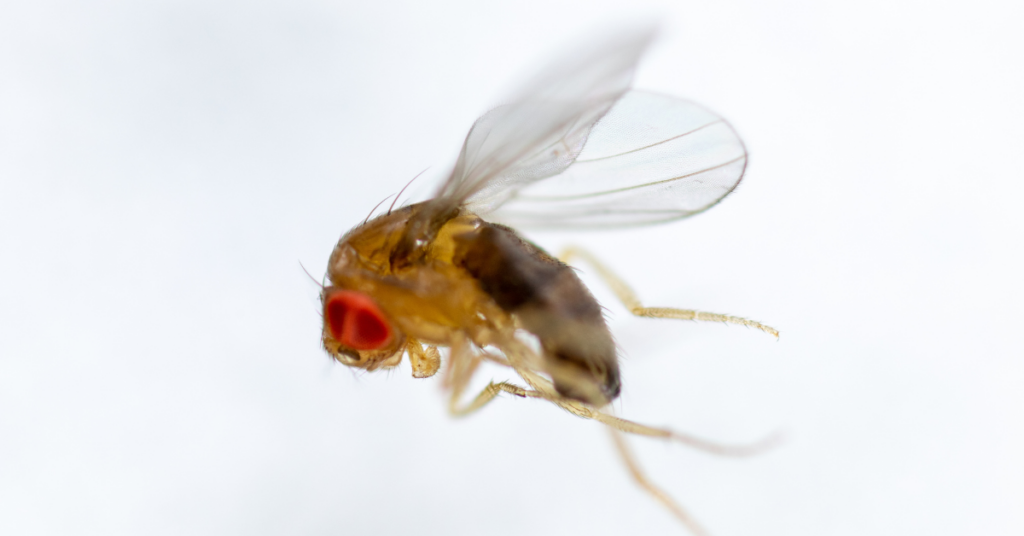
Drosophila melanogaster is the scientific name of the common fruit fly. Yes, the ones flying around your green bin on a hot summer day. You may be surprised to learn that it is a commonly used model organism in biomedical research and has made significant contributions to many fields of study.
Model Organisms
Biomedical research aims to understand biological systems in humans and how their disruption can lead to disease. However, many studies on humans come with ethical concerns and substantial limitations of high cost and slow results.
Thus, it is important to perform initial studies in other organisms with a biological system similar to ours that are easier to work with. Examples of common model organisms are bacteria, roundworms, zebrafish, mice, and the common fruit fly Drosophila melanogaster, which we will discuss here.
The History of Drosophila melanogaster
One of the earliest experimental uses of Drosophila melanogaster as a model organism was in 1910, when a mutation for the eye colour of a fruit fly led to the discovery of sex-linked inheritance.
Thomas Hunt Morgan, the researcher behind this work, was also awarded the Nobel Prize in Physiology or Medicine in 1933 for discovering the role of chromosomes in gene inheritance through his work using the fruit fly model. Since then, Drosophila melanogaster has been widely used in the study of embryogenesis, human diseases, and drug discovery.
Advantages and disadvantages
There are many advantages to choosing Drosophila melanogaster as a model organism. They are small, cheap and easy to maintain, and have a short generation time. Drosophila melanogaster has highly conserved basic biological, physiological, and neurological properties compared to humans, and it is estimated that 77% of disease-related genes in humans have similar counterparts in fruit flies.
Many fruit fly disease models have also been generated through genetic mutations to mimic and study human diseases, including cancer, metabolic disease, and neurological diseases.
The obvious disadvantage of the model is its dissimilarity to humans in terms of body structure. Fruit flies are invertebrates, meaning they do not have a spine, therefore, they are not a good model for diseases such as multiple sclerosis, which affects the brain and the spinal cord. They also do not have blood vessels, and their blood composition is vastly different from humans, preventing them from modelling related diseases such as stroke.
Nevertheless, due to the highly conserved molecular pathways, the model has greatly contributed to understanding our biological systems. Many discoveries were first made in the fruit fly, then translated to more complex organisms.
Ataxia research using Drosophila melanogaster
Several spinocerebellar ataxias, including SCA1 and SCA3, are caused by polyglutamine expansions in their corresponding genes. Due to this single-gene defect nature, many polyglutamine diseases were successfully modelled using Drosophila melanogaster by introducing the polyglutamine expansion in the fruit fly genome.
The models exhibit several characteristic features of the diseases, including abnormal protein aggregates containing the mutant protein, an inverse correlation between the length of the expansion and disease onset, and age-dependent neurodegeneration.
Many studies are utilizing these models to identify the effect of the disease-causing mutations on fruit fly development and how certain mutations or drug treatments may reverse or alleviate disease symptoms. Covered in another SCAsource article, a study conducted by Suart and colleagues identified that partial reduction of a DNA damage repair protein in SCA1 fly models resulted in reduced ataxia symptoms, and may be a potential therapeutic target for SCA1.
If you would like to learn more about the use of fruit flies in research, take a look at these resources by the Berg Lab at the University of Washington and Harvard Medical School.
To learn more about other types of model organisms, you can read our past articles on mice, zebrafish, and C. elegans.
Snapshot Written by: Christina (Yi) Peng
Edited by: Larissa Nitschke

Snapshot: What is Spasticity?
Spasticity is a condition where muscles involuntarily stiffen, impeding normal smooth movements. Spasticity can present in varying severities with varying impacts on daily life. For example, minor spasticity resulting in Read More…


Snapshot: What is Articulation?
Articulation refers to the ability to produce speech sounds using the tongue, lips, jaw, and the roof of your mouth. All of these organs are also known as articulators. The Read More…


Snapshot: What is Resonance?
In speech-language pathology, the term resonance refers to nasality in speech. In other words, how nasal a person’s speech sounds. When someone is congested, they likely sound hyponasal, or not Read More…









